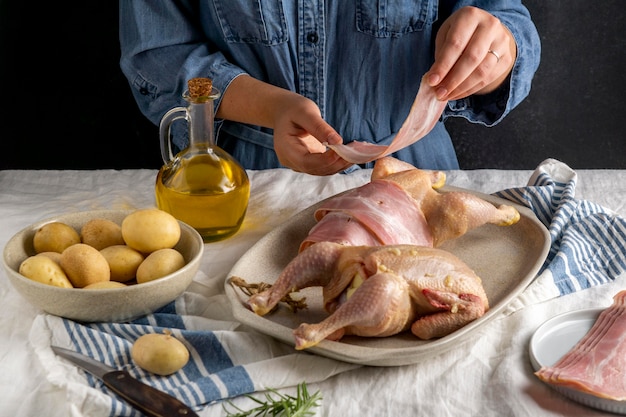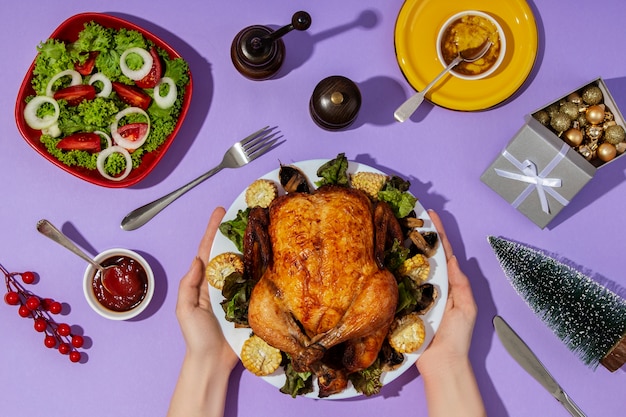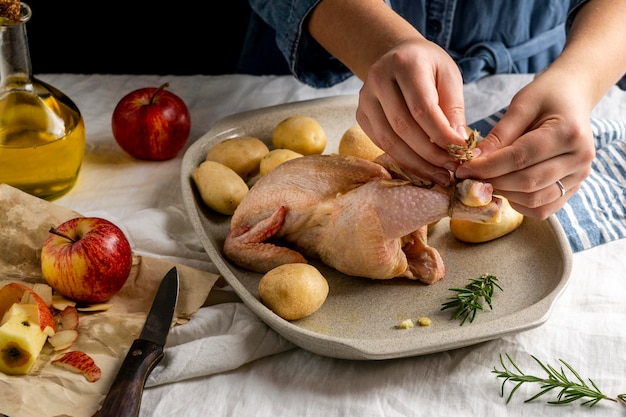Let's be honest, chicken is a kitchen hero. It's versatile, affordable, and a blank canvas for culinary creativity. But, we've all been there - a dry, rubbery chicken breast, or worse, the dreaded undercooked one. It's a culinary nightmare, but fear not! Through my own chicken cooking journey, filled with both triumphs and disasters, I've learned the secrets to consistently delicious chicken, and I'm here to share them with you.
This guide is your one-stop shop for all things chicken, covering everything from picking the right cut to mastering different cooking methods and even some handy tips to avoid common pitfalls. So, grab your apron, gather your spices, and let's get cooking!
(Part 1) Choosing Your Chicken: The First Step to Success

Picking the Right Cut: A Matter of Preference and Purpose
The first step is picking the perfect cut for your recipe. chicken breasts are fantastic for grilling, pan-frying, or baking, resulting in a lean and tender option. But for a juicier, more flavourful result, especially when roasting or slow cooking, I always recommend boneless, skin-on chicken thighs. They're simply more forgiving and less prone to drying out.
Reading the Labels: Ensuring Freshness and Quality
Always check the label for the best before date and ensure the packaging is intact. This is crucial for food safety. It's also worth noting the "use by" date. Nobody wants to be cooking a chicken that's been lounging in the fridge for a week!
Checking for Freshness: A Few Sensory Tests
Here's a little trick I've learned: give the chicken a sniff. It should smell neutral, almost sweet. If it has a sour or ammonia-like scent, it's best to steer clear. Also, check the color – it should be a pale, creamy colour.
(Part 2) Preparing Your Chicken: Setting the Stage for Flavor

Washing or Not Washing? The Great Chicken Debate
You'll find the "wash or don't wash" chicken debate is a hot topic in culinary circles. While some swear by washing their chicken, experts strongly advise against it. Why? Splashing water around can actually spread bacteria, increasing the risk of cross-contamination.
My advice? Skip the washing and pat the chicken dry with paper towels instead. This not only helps avoid bacteria but also contributes to a crispier skin and better browning.
Removing the Skin: A Lower-Fat Option
If you're looking for a lower-fat option, or simply prefer your chicken without skin, it's time for a little manual dexterity. Carefully remove the skin. This is easier with boneless, skin-on thighs, as you can gently pull the skin back.
Searing the Skin: Locking in Flavor and Creating a Crispy Crust
Now, if you're keeping the skin on, here's a little trick that elevates your chicken game: sear it before cooking! This helps lock in the juices and creates a deliciously crispy crust. Heat a pan over medium-high heat and add a touch of oil. Sear the chicken skin-side down for a few minutes until it turns a beautiful golden brown.
(Part 3) Cooking Methods: Exploring the World of Chickenbaking chicken: A Simple and Reliable Method
Baking is a fantastic way to cook a whole chicken or individual pieces. Preheat your oven to 375°F (190°C). Place the chicken on a baking sheet lined with parchment paper. Feel free to roast it plain or get creative with herbs and spices for added flavor. To ensure even cooking, make sure there's some space between the pieces.
grilling chicken: Adding a Smoky Touch
Grilling is the perfect way to infuse your chicken with a smoky flavor. Ensure your grill is clean and hot, around medium-high heat. If you're using gas, preheat it for 10-15 minutes. Brush the chicken with oil and season generously with your favorite spices.
pan-frying chicken: Quick, Easy, and Delicious
Pan-frying offers a quick and easy way to cook chicken. Heat a pan over medium-high heat and add a small amount of oil. Pat the chicken dry with paper towels and then add it to the pan. Use a spatula to press down on the chicken for a nice crispy surface.
Slow Cooking Chicken: A Tender and Flavorful Experience
Slow cooking is a fantastic option for tenderizing tougher cuts of chicken. Simply place the chicken in your slow cooker with your preferred sauce or marinade and cook on low for 6-8 hours. This method is perfect for creating melt-in-your-mouth chicken.
(Part 4) Mastering Doneness: Ensuring a Perfectly Cooked Chicken

Using a meat thermometer: The Gold Standard
The most reliable way to check if your chicken is cooked through is with a meat thermometer. Insert the thermometer into the thickest part of the chicken, making sure it doesn't touch any bones. The internal temperature should reach 165°F (74°C) for safety and deliciousness.
Checking for Doneness Without a Thermometer: A Few Visual and Tactile Clues
If you don't have a thermometer, you can still check for doneness using a few other methods. Press on the chicken: The flesh should be firm and springy to the touch. Another clue is the juices – they should run clear, not pink.
(Part 5) Elevating Your Chicken: Marinades and Seasonings
Marinades: Infusing Flavor and Moisture
Marinades are a fantastic way to infuse chicken with flavour and help keep it moist. Here are a few of my personal favorites:
Mediterranean: A vibrant blend of olive oil, lemon juice, garlic, oregano, and salt.
Asian: A bold combination of soy sauce, ginger, garlic, honey, and sesame oil.
Spicy: A fiery mix of hot sauce, paprika, cumin, garlic, and lime juice.
Remember to marinate the chicken for at least 30 minutes, or even better, overnight for maximum flavor penetration.
Seasoning Ideas: Adding Depth and Complexity
No matter how you're cooking your chicken, a little seasoning goes a long way. Here are a few of my go-to seasoning combinations:
Simple: The classic trio of salt, pepper, and garlic powder.
Herby: A fragrant mix of thyme, rosemary, parsley, and sage.
Spicy: A fiery combination of cayenne pepper, paprika, chili flakes, and cumin.
(Part 6) Serving Up Delicious Chicken: Recipes and Variations
chicken salad: A Classic with Endless Possibilities
A classic for a reason! Mix cooked chicken with mayonnaise, celery, onion, and herbs. It's perfect for sandwiches, salads, or as a light and satisfying meal.
Chicken Curry: A Fragrant and Flavorful Delight
This dish is packed with flavor. Cook chicken in a creamy curry sauce with vegetables, spices, and coconut milk. Serve it with rice or naan bread for a truly delicious meal.
Chicken Stir-Fry: Quick, Easy, and Versatile
A fantastic quick meal! Stir-fry chicken with your favorite vegetables and sauce. It's a great way to use up leftover chicken.
Chicken Soup: Comforting and Nourishing
A heartwarming and nourishing dish. Cook chicken in a flavorful broth with vegetables and noodles. It's perfect for a cold day or any time you need a comforting meal.
Chicken Enchiladas: A Mexican-Inspired Delight
A taste of Mexico! Fill tortillas with chicken, cheese, and your favorite fillings. Bake them in the oven with a delicious sauce.
Chicken Fajitas: A Tex-Mex Classic
A classic Tex-Mex dish. Marinate and grill chicken strips with peppers and onions. Serve them with tortillas, salsa, and guacamole.
(Part 7) Storage and Leftovers: Making the Most of Your Chicken
Storing Chicken Properly: Safe and Delicious
Store cooked chicken in an airtight container in the refrigerator for up to 3-4 days. Make sure to cool the chicken down quickly after cooking. You can do this by placing it in a shallow container in the refrigerator.
Reheating Chicken: Safety First
When reheating cooked chicken, ensure it reaches an internal temperature of 165°F (74°C). You can reheat it in the oven, microwave, or on the stovetop.
Using Leftover Chicken: Don't Waste a Delicious Opportunity
Don't let leftover chicken go to waste! It's a versatile ingredient that can be used in a variety of recipes. Here are a few ideas:
Chicken salad
Chicken soup
Chicken stir-fry
Chicken sandwiches
(Part 8) Tips and Tricks: perfect chicken Every Time
Don't Overcrowd the Pan: Ensuring Even Cooking
Whether you're pan-frying or baking chicken, avoid overcrowding the pan. This can lead to the chicken steaming instead of browning. Cook the chicken in batches if necessary.
Rest the Chicken: Letting the Juices Redistribute
Let the chicken rest for a few minutes after cooking before slicing or serving. This allows the juices to redistribute, resulting in a more tender and flavorful chicken.
Brine Your Chicken: A Secret for Extra Moisture and Flavor
For extra juicy and flavorful chicken, consider brining it. Brining involves soaking the chicken in a salt solution for a few hours. This helps retain moisture and flavor.
Invest in a Good Quality Meat Thermometer: A Reliable Tool for Perfect Chicken
A good meat thermometer is a must-have for any home cook. It will ensure your chicken is cooked to perfection and safe to eat.
Don't Be Afraid to Experiment: Embrace Your Culinary Creativity
Cooking chicken doesn't have to be boring. Get creative with your marinades, seasonings, and recipes. There are endless possibilities when it comes to chicken!
(Part 9) FAQs (Frequently Asked Questions)
Q: Can you cook chicken from frozen?
A: Yes, you can cook chicken from frozen, but it will take longer. Make sure the chicken reaches a safe internal temperature of 165°F (74°C). You can cook it in the oven, microwave, or on the stovetop.
Q: What are the best ways to tell if chicken is bad?
A: Chicken that's gone bad will have a sour or ammonia-like smell. It will also have a slimy texture. If you're unsure, it's better to err on the side of caution and throw it away.
Q: How long can I keep cooked chicken in the fridge?
A: Cooked chicken can be stored in the fridge for up to 3-4 days. Make sure to cool it down quickly after cooking and store it in an airtight container.
Q: What's the best way to avoid dry chicken?
A: Here are a few key tips:
Don't overcook it.
Use a meat thermometer to check the internal temperature.
Marinate the chicken for extra moisture.
Q: What are some healthy chicken recipes?
A: There are countless healthy chicken recipes! Here are a few ideas:
Grill chicken with vegetables.
Make a chicken stir-fry with brown rice.
Prepare a chicken salad with whole-wheat bread.
I hope this ultimate guide has given you all the information you need to cook perfect chicken every time. So, get out there, get cooking, and enjoy the deliciousness of a perfectly prepared chicken dish!
Everyone is watching

Prime Rib Roast Cooking Time Chart: Per Pound Guide
Cooking TipsPrime rib roast. Just the name conjures images of lavish dinners, crackling fires, and hearty laughter. It’s ...

How Long to Bake Potatoes in the Oven (Perfect Every Time)
Cooking TipsBaked potatoes are a staple in my kitchen. They're incredibly versatile, delicious, and surprisingly easy to m...

Perfect Rice Every Time: The Ultimate Guide to Cooking Rice
Cooking TipsAs a self-proclaimed foodie, I've always been a bit obsessed with rice. It's the foundation of countless cuisi...

The Ultimate Guide to Cooking Asparagus: Tips, Techniques, and Recipes
Cooking TipsAsparagus. The mere mention of this spring delicacy conjures up images of vibrant green spears, crisp and burs...

Ultimate Guide to Cooking the Perfect Thanksgiving Turkey
Cooking TipsThanksgiving. Just the word conjures up images of overflowing tables laden with delicious food, the scent of r...
